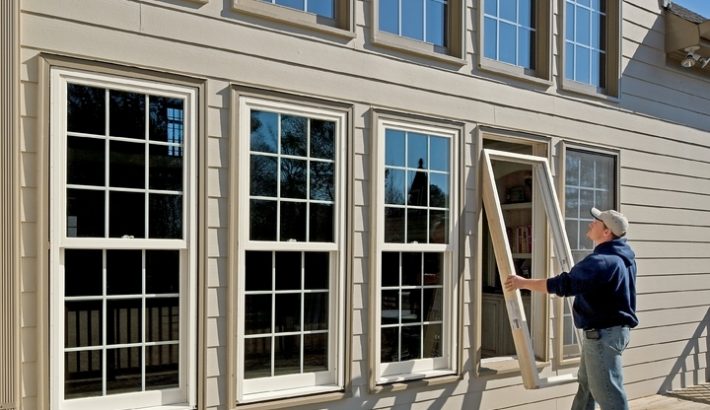Enhancing Energy Efficiency with New Window Installations
Energy efficiency is a growing priority for homeowners and commercial property managers alike. With rising energy costs and increasing environmental awareness, making homes and buildings more energy-efficient has become a significant focus. One of the most impactful ways to improve energy efficiency is through window installation. Installing new windows designed with energy-saving features can reduce your energy consumption, enhance comfort, and even increase the value of your property.
In this article, we’ll explore the benefits of installing energy-efficient windows, how they work, and what you should consider when planning a window installation. From understanding energy ratings to choosing the right materials, this guide will help you make informed decisions about upgrading your windows.
1. The Role of Windows in Energy Efficiency
Windows are a critical factor in determining your home’s energy efficiency. Poorly insulated windows can cause significant heat loss in the winter and excessive heat gain in the summer, forcing your HVAC system to work harder and increasing your energy bills. Window replacement with energy-efficient models can help mitigate these problems.
a. Heat Transfer and Insulation
Windows are a primary point of heat transfer in buildings. In the winter, poorly insulated windows allow heat to escape, while in the summer, they can let unwanted heat in. Energy-efficient windows are designed to minimize this heat transfer, keeping your home warm in the winter and cool in the summer. This reduces the strain on your heating and cooling systems, lowering your energy usage.
b. The Importance of Seals
One of the most common issues with older windows is the failure of window seals. When seals degrade, they allow drafts and moisture to seep in, compromising the window’s insulating properties. Ensuring proper sealing during your window installation or glass repair can significantly improve your home’s energy performance.
By addressing these key areas, energy-efficient windows help regulate indoor temperatures, making your living space more comfortable year-round.
2. How Energy-Efficient Windows Work
Energy-efficient windows incorporate advanced technologies and materials to improve insulation and reduce energy loss. These windows are designed to block heat transfer, reflect UV rays, and create an airtight barrier between the indoor and outdoor environments.
a. Low-E Glass
Low-emissivity (Low-E) glass is a popular choice for energy-efficient new windows. This type of glass features a special coating that reflects infrared light, keeping heat inside during the winter and outside during the summer. Low-E glass also blocks harmful UV rays, which can cause fading of furniture, flooring, and artwork.
b. Double and Triple Pane Windows
Multi-pane windows are another important feature of energy-efficient windows. Double-pane and triple-pane windows have two or three layers of glass with insulating gas, such as argon or krypton, sealed between them. These layers provide superior insulation compared to single-pane windows, reducing heat transfer and improving overall energy efficiency.
c. Gas Fills
The space between panes in double or triple-pane windows is often filled with an inert gas like argon or krypton. These gases are denser than air, providing better insulation and further reducing the amount of heat that passes through the window. Gas-filled windows are a key component in reducing energy consumption and maintaining a comfortable indoor temperature.
These technologies combine to create windows that not only improve your home’s comfort but also contribute to significant energy savings over time.
3. Benefits of Energy-Efficient Windows
Investing in energy-efficient window installation comes with numerous advantages. While the initial cost may be higher than standard windows, the long-term savings and benefits make it a worthwhile investment.
a. Lower Energy Bills
One of the most immediate benefits of installing energy-efficient windows is the reduction in energy bills. By improving insulation and preventing heat loss or gain, these windows reduce the need for heating and cooling. Over time, the savings on energy bills can offset the initial cost of the window installation, making it a financially sound decision.
b. Increased Comfort
Energy-efficient windows help maintain a consistent indoor temperature by minimizing drafts and cold spots. In the winter, you’ll experience fewer chills near the windows, and in the summer, your home will stay cooler without the need to constantly run the air conditioner. This increased comfort is one of the main reasons homeowners choose to upgrade their windows.
c. Environmental Impact
In addition to saving on energy costs, energy-efficient windows also reduce your home’s carbon footprint. By using less energy to heat and cool your home, you contribute to a reduction in greenhouse gas emissions. For eco-conscious homeowners, new windows that enhance energy efficiency align with sustainable living goals.
d. Enhanced Property Value
Installing energy-efficient windows is an excellent way to increase the resale value of your home. Prospective buyers are increasingly looking for energy-efficient features, and windows are a key selling point. Well-insulated windows improve the overall appeal of a property, making it more attractive to environmentally aware buyers.
4. Choosing the Right Windows for Your Home
When selecting new windows, it’s important to consider several factors to ensure you get the best energy efficiency and performance. Here are some key aspects to evaluate:
a. Energy Star Ratings
The Energy Star label is a trusted indicator of a product’s energy efficiency. Windows that carry the Energy Star certification meet strict guidelines set by the U.S. Environmental Protection Agency (EPA) and the Department of Energy (DOE). These windows are designed to provide superior insulation and reduce energy consumption.
b. Window Frame Materials
The material used for your window frames can also impact energy efficiency. Vinyl, fiberglass, and wood-clad frames offer excellent insulation and durability. Vinyl is the most common material for energy-efficient windows because it is low-maintenance, weather-resistant, and provides good insulation. Fiberglass is also highly energy-efficient and can withstand extreme temperatures without warping.
Wood-clad windows provide natural insulation, but they require more maintenance than vinyl or fiberglass. The right frame material will depend on your specific climate, aesthetic preferences, and maintenance capabilities.
c. U-Value and Solar Heat Gain Coefficient (SHGC)
When choosing windows, look for the U-value and SHGC ratings. The U-value measures how well the window prevents heat from escaping, with lower values indicating better insulation. The SHGC measures how well the window blocks heat from the sun; lower SHGC ratings are ideal for hot climates, while higher SHGC ratings can help homes in colder climates capture warmth from the sun.
By considering these factors, you can select windows that offer the best balance of insulation, durability, and energy savings for your specific needs.
5. Professional Installation: The Key to Maximizing Energy Efficiency
Even the most energy-efficient windows will not perform well if they are improperly installed. Poor installation can lead to air leaks, moisture infiltration, and compromised insulation. Working with experienced professionals ensures that your new window installation is done correctly and that the windows are properly sealed and aligned.
a. Sealing and Insulation
Proper sealing around the windows is critical to ensuring energy efficiency. During installation, professionals use high-quality caulking and weatherstripping to create an airtight seal, preventing drafts and moisture from entering the home. This step is essential for maintaining the insulating properties of the new windows.
b. Window Alignment
Misaligned windows can cause operational issues and reduce energy efficiency. Professional installers ensure that the windows are properly aligned, allowing them to open and close smoothly while maintaining their insulation. By hiring experts, you can avoid costly mistakes that compromise the performance of your windows.
Conclusion
Upgrading to energy-efficient windows is one of the most effective ways to improve your home’s comfort, lower energy bills, and reduce your environmental impact. From advanced glass technologies like Low-E coatings and gas-filled panes to professional window installation, every aspect of the process contributes to better insulation and overall energy performance.
When considering new windows, it’s essential to work with trusted professionals to ensure the installation is done correctly and that your windows provide maximum efficiency. By choosing the right materials, technologies, and installation team, you can enjoy a more energy-efficient home for years to come.






